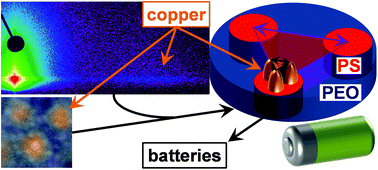Revealing the growth of copper on polystyrene-block-poly(ethylene oxide) diblock copolymer thin films with in situ GISAXS†
Abstract
Copper (Cu) as an excellent electrical conductor and the amphiphilic diblock copolymer polystyrene-block-poly(ethylene oxide) (PS-b-PEO) as a polymer electrolyte and ionic conductor can be combined with an active material in composite electrodes for polymer lithium-ion batteries (LIBs). As interfaces are a key issue in LIBs, sputter deposition of Cu contacts on PS-b-PEO thin films with high PEO fraction is investigated with in situ grazing-incidence small-angle X-ray scattering (GISAXS) to follow the formation of the Cu layer in real-time. We observe a hierarchical morphology of Cu clusters building larger Cu agglomerates. Two characteristic distances corresponding to the PS-b-PEO microphase separation and the Cu clusters are determined. A selective agglomeration of Cu clusters on the PS domains explains the origin of the persisting hierarchical morphology of the Cu layer even after a complete surface coverage is reached. The spheroidal shape of the Cu clusters growing within the first few nanometers of sputter deposition causes a highly porous Cu–polymer interface. Four growth stages are distinguished corresponding to different kinetics of the cluster growth of Cu on PS-b-PEO thin films: (I) nucleation, (II) diffusion-driven growth, (III) adsorption-driven growth, and (IV) grain growth of Cu clusters. Percolation is reached at an effective Cu layer thickness of 5.75 nm.



 Please wait while we load your content...
Please wait while we load your content...